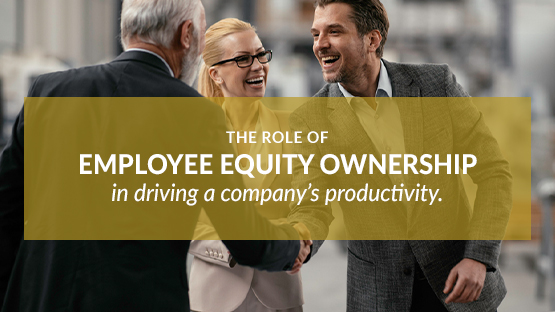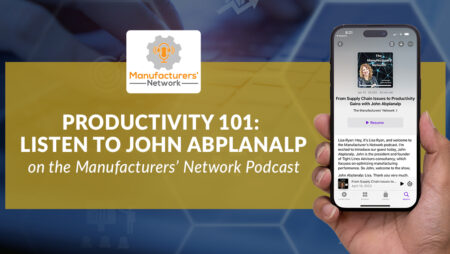
By John Abplanalp
In recent articles, I have written about how businesses that lack a defined and unifying purpose experience lower productivity; shared my thoughts on how companies can drive growth through the unification of purpose; and offered a methodology for driving value creation and sustainable prosperity. In this article, the focus is on driving productivity by turning employees into owners through the implementation of an equity ownership offering (either real or synthetic). In giving employees a stake in the company, the objective is to motivate them to do what is best for the shareholders since they are also shareholders.
In addition to the hourly wages that they receive for their designated job-related activities, we also want to reward them for their relevant, collective, and collaborative ongoing contributions in driving the effectiveness and efficiency of the organization.
Increasingly, employee equity ownership offerings are becoming a viable option for companies looking to sustain a legacy and receive market value for an organization they worked hard over the years to build. Several paths lead to employee ownership. Selecting the best path will depend on a variety of factors, including your company’s size and your business goals.
Broad-based employee ownership helps to create and maintain quality jobs, creates stronger businesses, and preserves your company’s legacy. Some of the more recognized options include Worker Cooperatives, Employee Stock Ownership Plans (ESOPs), Employee Ownership Trusts, and other viable alternatives. Each model of employee ownership has differentiating characteristics that will help assist in determining what may work best for your company.
When a company wants to compensate with a form of ownership equity, there are a variety of alternatives. It may establish a trust in which to contribute either new shares of the company’s stock or cash to buy existing stock. Up to certain limits, these trust contributions are tax-deductible. The shares are then allocated to all individual employee accounts. A common formula for allocation is in proportion to an employee’s years of service, compensation, or in certain instances, both. New employees, when appropriate, can become part of a company equity offering and after they have completed a designated period of time, start receiving those allocations.
When employees who are members of an employee equity ownership offering leave a company, they receive their equity in stock or other form, depending on the circumstances. Companies that are privately held are required to buy back the departing employee’s shares at fair market value within 60 days of the employee’s departure. Private companies also must have an annual stock valuation to determine the price of the shares.
The term “employee-owned corporation” is used to describe majority employee-ownership corporations, and in some ways are comparable to worker cooperatives. The difference is that with an employee stock ownership plan, as compared to a worker corporative, the company’s capital is not evenly distributed. In some instances, senior employees may allocate more shares than newly hired employees, and therefore, the latter exercise less voting power during shareholder meetings.
Most companies with an equity ownership offering want employees who think and act like the employee-owners. Extensive research and years of accumulated information indicate that employee ownership can be utilized as a powerful tool to improve corporate productivity – but only when a company has an “ownership culture” in which employees effectively act and think as an owner would. It means being nice/professional to customers, coming to work on time, cutting down on waste, and working hard on the job. However, an ownership culture encompasses a great deal more than that and needs to be methodically and appropriately managed and led.
Research also shows that a successful ownership culture generates many ideas from a workforce that is highly involved and well-informed. Companies with these high-involvement, idea-generating cultures, produce an incremental 6% to 11% added growth per year over what their prior performance relative to their industries would have predicted. This idea-generation environment is analogous to that which is generated by the productivity system we utilize at Tight Lines Advisors. Our Performance Accelerator program creates value from the inside out for all stakeholders and is founded on sustainable increases in productivity that are made possible through the unified efforts of a purpose-driven organization.
Realizing double-digit growth – in revenue and profitability – is the result of a purpose-driven, highly productive workplace centered around a company equity ownership culture. Building that culture begins with defining and communicating organizational values, tying them to your performance management process, and rewarding employees for their contributions. Developing a people strategy around your ideal culture will generate change. As companies analyze whether they should compensate employees with company equity, owners and management teams would be wise to account for its impact on the culture of the firm. Ensuring companies have the right teams, metrics, focus, and processes in place to motivate and encourage all employees to act and think like owners are critical to sustainable productivity and long-term success. While original shareholders may see their percentage of ownership decrease, the projected growth more than compensates for whatever is given up.
Creating an active and vibrant ownership culture requires a myriad of things. Monetarily speaking, employees should be provided with a meaningful ownership stake, enough to be a significant part of their financial security. Educationally, they should be taught how the company makes its money, how profits are generated, and their role in making it happen. The company should also share the numbers and data about how it is performing and how each team or workgroup contributes to it. Business literacy is also important, so people should be taught so they understand the numbers the company shares with them. As I mentioned earlier, allowing employees to contribute ideas and information is a strong tool in building culture and can be multiplied by making this involvement part of their everyday work through teams, feedback opportunities, devolution of authority, and other structures.
Employee equity ownership approaches are for all kinds and sizes of companies. One of if not the largest and most notable of majority employee-owned companies is Publix supermarkets with more than 225,000 employees. On a lesser scale, industrial components manufacturer, Amsted Industries has 18,000 employees, and Davey Tree Experts, employee-owned for more than forty years, boasts a workforce of approximately 10,500. On an even smaller scale, Michigan-based Challenge Manufacturing Company employs about 3,000, while industrial cutting solutions company Hypertherm has 1,300 people.
One company that epitomizes the purpose-driven organization and illustrates the best aspects of an employee ownership culture is W.L. Gore & Associates, one of the largest, and most successful, employee-owned companies in the U.S.
The Company, best known for Gore-Tex, a waterproof, windproof membrane used in a wide variety of applications, consistently ranks among the best companies to work for by Forbes, The Great Place to Work Institute, and Fast Company. One of the key reasons for the company’s success is its focus on culture. Workplace experts have devoted time and energy to understand what makes this company so successful and have implemented the findings across other firms. W.L. Gore has long focused on building a sustainable, “conscious culture.” Its founders sought to combat traditional management hierarchies, and to this day, all employees are known as “associates.”
The late Bill Gore expressed his vision for the organization that bears his name with these words, “I dreamed of an enterprise with great opportunity for all who would join in it, a virile organization that would foster self-fulfillment and which would multiply the capabilities of the individuals comprising it beyond their mere sum.”
His vision continues to empower individuals and cultivates a value system that encourages all associates to look at results not only financially but also in emotional terms. This corporate culture translates to associate loyalty; as of 2019, full-time turnover at Gore was reported to be less than 3.5%. That number is a remarkably low metric in the manufacturing industry. With more than $3 billion in annual revenues and more than 9,000 employees, the results of corporate culture are clear. Motivating and empowering associates to think like owners have had a dramatic and positive effect on the company’s success.
The National Center for Employee Ownership (NCEO) conducted an extensive investigation of the impact of employee ownership and the culture of a firm. In keeping with the example of W.L. Gore & Associates, the study found a correlation between the number of shares owned by employees and their overall satisfaction. Findings of the study revealed that employees tended to be more committed to the company, more satisfied, and less likely to voluntarily leave it. Second to ownership, was a cultural impact. Firms have enhanced employee retention and motivation by regularly providing insight into the companies’ performance, as well as incorporating many opportunities for participation in operating decisions. Therefore, companies converting to some form of an employee equity ownership offering would be well served to use the vehicle to enlist employee ideas and employee participation across departments to yield more meaningful results.
So, is compensating your employees with some form of company equity or equivalent right for your organization? As I have outlined here, there certainly are benefits to implementing one. However, they are not for everyone. Making the call is a complex decision that requires considerable research, analysis, and evaluation. My view is to approach decisions like this positively but pragmatically and take the long view as a key factor.
Speaking regularly with business executives on a wide range of topics from productivity and value creation to sustainable profitability and, yes, compensating your employees with company equity rights, affords me a great opportunity to share my knowledge and experience. These talks are always energetic, revealing, and full of ideas. If you are interested in having a conversation, consider this an invitation.
You can also catch up with my other recent articles, Rethinking the Purpose of a Corporation here, and “Purpose, Productivity and Profitability – The Confluence of Company Sustainability here.




